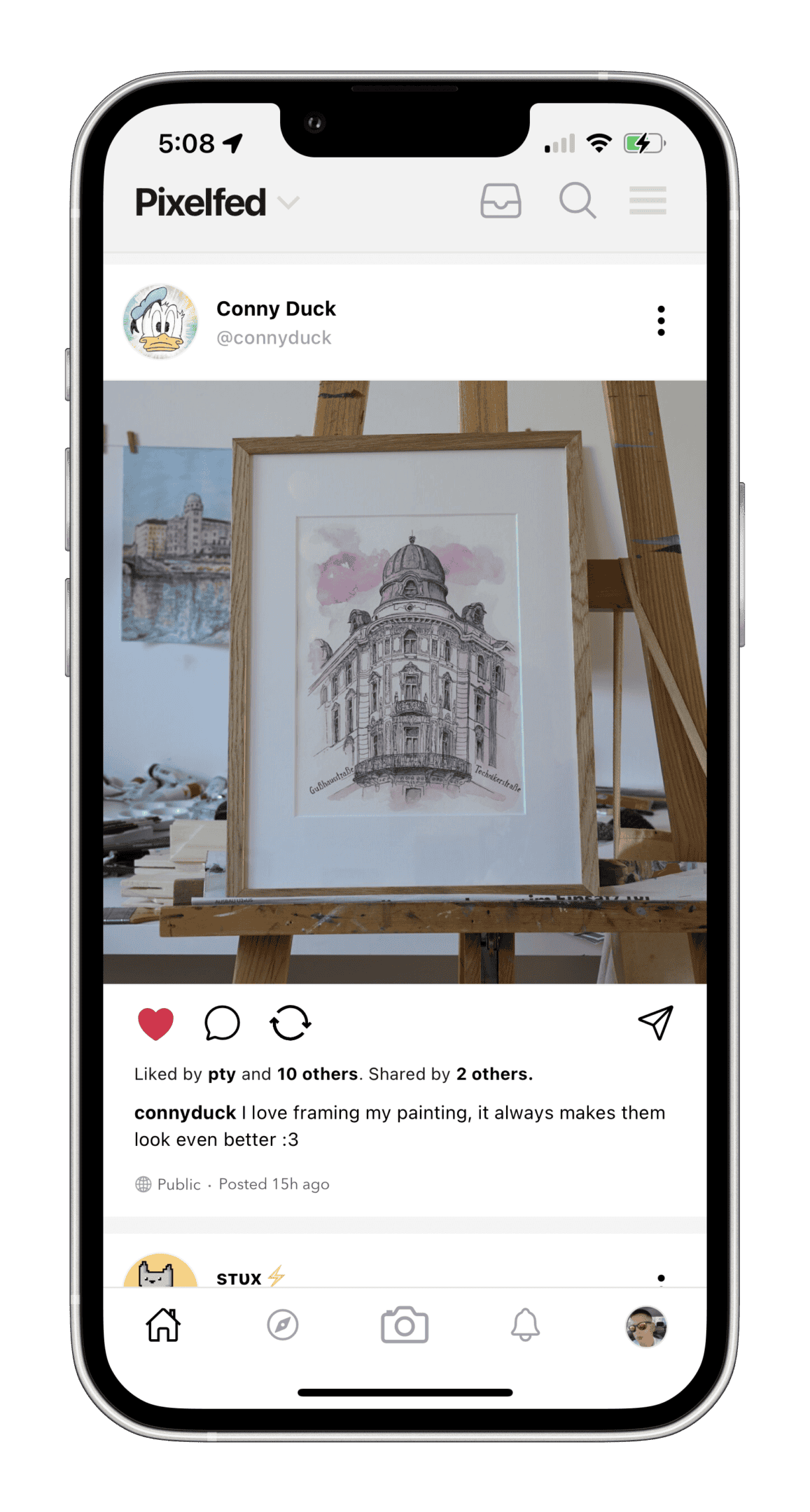
You may have heard of Pixelfed (and the fact that Meta is blocking links to it on their properties) – but what exactly is it? Pixelfed offers a fresh take on photo sharing. This free, open-source platform provides an alternative to mainstream social media sites. Pixelfed operates on a decentralized network, giving users more control over their data and content.
Users can share images, follow others, and interact across different Pixelfed instances. The platform connects to the wider Fediverse, allowing communication with users on other ActivityPub-based networks like Mastodon. This interoperability sets Pixelfed apart from centralized services.
Pixelfed emphasizes privacy and user rights. It lacks the intrusive algorithms and data mining practices common on larger social networks. The platform’s design focuses on simplicity and ease of use, making it accessible to those seeking a more ethical photo sharing experience.
Pixelfed: A Photo-Sharing Platform with a Difference
Pixelfed is a free and open-source social network that lets you share photos with friends and family. Think of it like Instagram, but with a strong emphasis on privacy and user control. It’s part of a growing movement towards decentralized social media, offering an alternative to the big players like Facebook and Instagram.

What Makes Pixelfed Different?
- Decentralized: Unlike Instagram, where all your data is stored on one central server, Pixelfed is spread across many different servers, called instances. This means no single company controls your data or the entire network.
- Privacy-Focused: Pixelfed doesn’t track your activity or show you ads. You have more control over your data and who can see your posts.
- Community-Driven: Each Pixelfed instance has its own community and moderators, creating a more intimate and engaging experience.
- Open-Source: The code behind Pixelfed is publicly available, meaning anyone can inspect it, contribute to it, or even create their own instance.
How Does Pixelfed Work?
You can sign up for an account on any Pixelfed instance. Once you’re in, you can share photos, follow other users, and interact with their posts. Because Pixelfed is part of the Fediverse (a network of interconnected social media platforms), you can also connect with people on other platforms like Mastodon.

Why Choose Pixelfed?
If you’re looking for a photo-sharing experience that prioritizes privacy, community, and user freedom, Pixelfed is worth checking out. It’s a refreshing alternative to the mainstream social media giants, offering a more ethical and empowering way to connect with others online.
Key Takeaways
- Pixelfed is a decentralized, open-source alternative to traditional photo sharing platforms
- Users can interact across Pixelfed instances and other Fediverse networks
- The platform prioritizes user privacy and data control
What Is Pixelfed?
Pixelfed is an alternative social media platform focusing on online privacy, openness, transparency, and user control. It fosters a growing community committed to ethical social media, making it a conscious option for sharing photos online.
Pixelfed is a decentralized, open-source image sharing platform. It offers a privacy-focused alternative to traditional social media networks for photo enthusiasts and content creators.
Core Ideology
Pixelfed embraces decentralization and user privacy. It operates on the ActivityPub protocol, allowing users to interact across different Fediverse platforms. This means Pixelfed users can connect with people on Mastodon, PeerTube, and other compatible networks.
The platform’s open-source nature lets anyone host their own Pixelfed instance. This distributed approach prevents data centralization and gives users more control over their information.
Pixelfed aims to create a more ethical social media environment. It prioritizes user rights and data ownership, setting it apart from mainstream platforms that often monetize user data.
User Experience
Pixelfed offers a familiar interface for users transitioning from other photo-sharing apps. It includes features like photo uploads, filters, and hashtags.
Users can follow others, like posts, and comment on images. The platform supports both public and private accounts, giving users control over their content’s visibility.
Pixelfed instances can be customized to suit specific communities or interests. This flexibility allows for niche photo-sharing spaces tailored to particular groups or themes.
The platform’s federated nature means users can interact with people across different Pixelfed instances and other Fediverse networks.
Community Standards
Pixelfed empowers instance administrators to set and enforce their own community guidelines. This localized approach allows for more targeted moderation based on each community’s needs.
The platform encourages respectful interaction and content sharing. Many instances have policies against hate speech, harassment, and explicit content.
Users can report inappropriate content or behavior to their instance moderators. This community-driven moderation helps maintain a positive environment for all users.
Pixelfed’s decentralized structure allows users to choose instances that align with their values and desired community standards. This gives users more agency in shaping their social media experience.
Key Features of Pixelfed
Pixelfed offers a range of features that enhance photo sharing and social interaction. Users can enjoy privacy controls, content discovery options, engagement tools, and media management capabilities.
Privacy and Security
Pixelfed prioritizes user privacy and security. The platform allows users to set their accounts as public or private. Private accounts restrict access to approved followers only. Users can also create unlisted posts, visible only to those with a direct link.
Two-factor authentication adds an extra layer of security to accounts. This feature requires a second form of verification beyond a password, reducing the risk of unauthorized access.
Pixelfed uses the ActivityPub protocol, enabling decentralized communication between different instances. This decentralization limits the concentration of user data in a single location, enhancing overall privacy.
Content Discovery
Pixelfed provides several ways for users to find and explore content. The Discover page showcases popular posts and trending hashtags. Users can search for specific topics or accounts using the search function.
Hashtags play a key role in content discovery. Users can add tags to their posts, making them easier to find. Clicking on a hashtag reveals related posts from across the platform.
The Local feed displays posts from users on the same instance, fostering community engagement. A Federated feed shows content from connected instances, broadening the scope of discoverable content.
Interaction and Engagement
Pixelfed offers various tools for user interaction. Comments allow users to discuss and react to posts. The platform supports threaded comments, making conversations easy to follow.
Users can like posts to show appreciation. The number of likes a post receives can indicate its popularity within the community.
Direct messaging enables private conversations between users. This feature facilitates one-on-one communication and sharing of content privately.
Sharing options allow users to spread content they enjoy. Users can repost interesting photos to their own followers, increasing content visibility.
Media Management
Pixelfed provides robust media management features. Users can create albums to group multiple photos into a single post. This feature is useful for sharing event photos or themed collections.
The platform supports various image formats and sizes. Users can upload high-quality images without compression, preserving photo integrity.
Filters and editing tools allow users to enhance their photos before posting. These features help users achieve their desired aesthetic without needing external editing software.
Collections enable users to organize saved posts. Users can create themed collections, making it easy to revisit and share favorite content later.
Pixelfed and the Fediverse
Pixelfed connects to the wider Fediverse, allowing users to interact across different platforms. This integration enhances user experience and expands content reach.
Interoperability with Mastodon
Pixelfed users can follow and interact with Mastodon accounts seamlessly. This cross-platform functionality enables photo sharing to a broader audience. Users on Mastodon see Pixelfed posts in their home timelines, just like native content.
The interoperability extends beyond simple viewing. Mastodon users can comment on Pixelfed posts, and these interactions appear on both platforms. This feature creates a unified social media experience across the Fediverse.
Pixelfed’s compatibility with Mastodon showcases the power of decentralized networks. It breaks down barriers between platforms, giving users more control over their online presence.
Advantages of Federation
Federation in Pixelfed offers several benefits:
- Increased privacy
- Greater user control
- Reduced reliance on a single company
Users can choose their preferred instance, each with its own rules and focus. This choice allows individuals to find communities that align with their values.
Federation also promotes innovation. Different instances can experiment with features without affecting the entire network. This flexibility leads to a diverse ecosystem of options for users.
The decentralized nature of federation makes it harder for any single entity to dominate the network. This structure protects user data and resists centralized control.
ActivityPub Integration
ActivityPub is the protocol that enables Pixelfed’s federation. It allows different platforms to communicate and share content seamlessly. This integration is key to Pixelfed’s participation in the Fediverse.
ActivityPub works by standardizing how social media posts and interactions are shared. When a user posts on Pixelfed, ActivityPub translates this action into a format other platforms can understand.
This protocol enables:
- Cross-platform following
- Content sharing between different services
- Unified notifications across the Fediverse
ActivityPub’s open nature allows developers to create new, compatible services easily. This openness fosters a growing ecosystem of interconnected platforms, with Pixelfed playing a significant role in photo sharing within this network.
Community Guidelines and Safety
Pixelfed’s community guidelines and safety measures aim to create a secure and respectful environment for users. These policies address content moderation, user behavior, and reporting mechanisms to maintain platform integrity.
Handling Sensitive Content
Pixelfed has strict rules for sensitive content. The platform prohibits violent media, explicit material, and graphic imagery. Users must mark potentially disturbing content with content warnings. This allows others to choose whether to view it.
Age restrictions apply to Pixelfed. The minimum age is 16 in most regions, with some areas setting it at 13. This helps protect younger users from inappropriate content.
Pixelfed bans the sharing of private information without consent. This includes personal details, addresses, and financial data. The platform takes a firm stance against doxxing to protect user privacy.
Promoting a Healthy Community
Pixelfed fosters an inclusive atmosphere by banning discriminatory behavior. This includes racism, sexism, homophobia, transphobia, and xenophobia. The platform does not tolerate hate speech or targeted harassment.
Users must respect others’ identities. Targeted misgendering and deadnaming are prohibited. Pixelfed also bans content promoting conversion therapy or other harmful practices.
The platform encourages positive interactions. It discourages dogpiling or mass targeting of individuals. Users should engage in constructive discussions and avoid personal attacks.
Reporting and Enforcement
Pixelfed relies on user reports to identify rule violations. The platform provides easy-to-use reporting tools for flagging problematic content or behavior.
Moderators review reports promptly. They may remove content, issue warnings, or suspend accounts based on the severity of the violation. Repeat offenders face permanent bans.
Pixelfed takes a strong stance against violent ideologies and incitement of violence. Such content is swiftly removed to maintain community safety.
The platform regularly updates its guidelines. This ensures they address new challenges and maintain a safe environment for all users.
Frequently Asked Questions
Pixelfed users often have questions about the platform’s features, differences from other social networks, and technical aspects. These common inquiries help clarify Pixelfed’s unique attributes and functionality.
What are the main uses of Pixelfed?
Pixelfed serves as a platform for sharing photos and visual content. Users can post images, follow other accounts, and interact with content through likes and comments. The service also supports image filters and editing tools.
Photographers and artists often use Pixelfed to showcase their work. Some users prefer it as an alternative to mainstream social media platforms due to its focus on privacy and decentralization.
Is there an official Pixelfed application available for mobile devices?
Pixelfed does not currently offer an official mobile app. Users access the platform through web browsers on their smartphones or tablets. Some third-party apps may exist, but these are not officially supported by the Pixelfed project.
The lack of a dedicated mobile app is a notable difference from Instagram and other popular image-sharing platforms. This aspect may impact user adoption and convenience for some individuals.
How does Pixelfed differentiate itself from Instagram?
Pixelfed’s key differentiator is its decentralized structure. Unlike Instagram, which stores all user data on centralized servers, Pixelfed operates on a network of independent instances. This approach gives users more control over their data and privacy.
Pixelfed also integrates with other decentralized social networks through the ActivityPub protocol. This feature allows users to interact with accounts on platforms like Mastodon and PeerTube, creating a more interconnected social experience.
The platform emphasizes open-source development and community-driven features. It aims to provide a more ethical and transparent alternative to mainstream social media services.
What are some prominent Pixelfed instances?
Pixelfed instances are independently operated servers that host user accounts and content. Some well-known instances include pixelfed.social, pixelfed.de, and pxlfd.me. These servers vary in size, rules, and user base.
Users can choose an instance based on factors like geographic location, content policies, or community focus. The ability to select a preferred instance gives users more control over their online environment.
How does Pixelfed support its platform financially?
Pixelfed relies primarily on community support for funding. Instance administrators often cover hosting costs themselves or seek donations from users. Some instances may offer premium features or request voluntary contributions to sustain operations.
The project’s open-source nature allows developers to contribute their time and skills to improve the platform. This collaborative approach helps reduce overall development costs.
Can you provide an overview of Pixelfed’s user base size?
Exact user numbers for Pixelfed are difficult to determine due to its decentralized nature. The platform’s user base is smaller than that of major centralized social networks like Instagram or Facebook.
Pixelfed appeals to users interested in privacy, decentralization, and open-source software. Its growth is gradual, driven by word-of-mouth and interest from tech-savvy individuals and privacy advocates.






